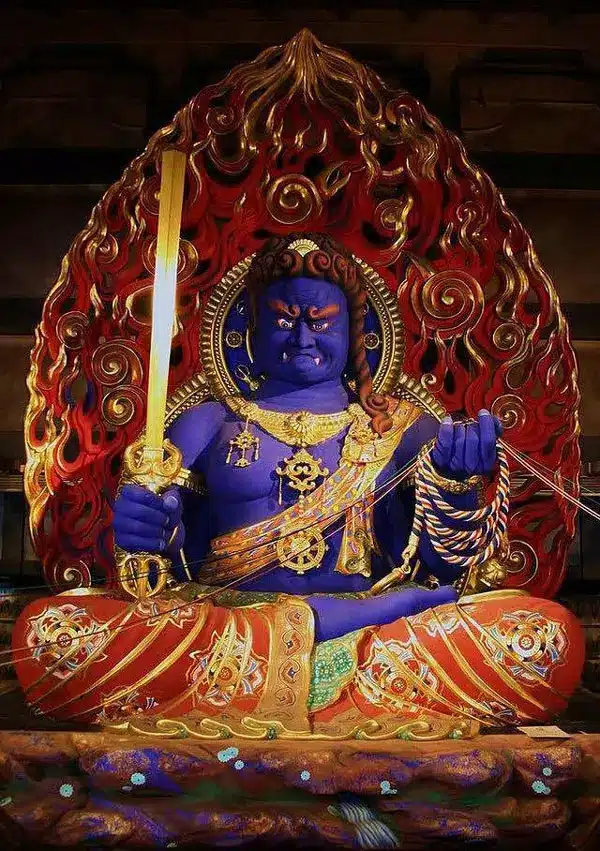Have you ever seen a very fierce-looking Buddha, different from the gentle face of Avalokiteshvara Bodhisattva or Shakyamuni Buddha,… He is Acala Vidyaraja, and in the following article Here we will learn about this strange Buddha and his powerful mantra!
The Acala Vidyaraja mantra is one of the popular mantras in Tantric Buddhist schools. He often appears near the center of the Tibetan mandala works. A protector of Buddhism who wards off evil spirits and removes all obstacles.
Who is Acala Vidyaraja in Buddhism?

Acala Vidyaraja is a ferocious deity and is related to Vairocana Tathagata. He is often depicted as a messenger, but his main task in the Mahāvairocana Sutra is to help remove the obstacles that prevent one from realizing the inherent goodness within.
“Acala” means “immovable”. “Vidya” means knowledge, but is also a synonym for mantra and is often used to refer to magic, something like esoteric knowledge. Rāja means “king”. Acala Vidyārāja is one of the 5 Vidyārājas of Tantric Buddhism.
In Tantric Buddhism, Akshobhya also means “immovable”, who presides over clans of gods such as Acala Vidyārāja. Other sources refer to Acala Vidyārāja as an “incarnation” of Akshobhya Buddha, showing similarities between the two.
Acala Vidyaraja is highly revered in Vajrayana Buddhism, especially in the Tangmi school, where Acala Vidyaraja is known as Fudo Myoo. In Japan, he is revered in Shingon Buddhism, Nichiren Buddhism, Tendai, Zen and Shugendo.
He is also revered in Japan’s most notorious gang, the Yakuza, who often have his expression and ferocious attitude tattooed on his body. He was a protector of the Dharma and a wise king. Some schools of Buddhism regularly practice chanting the Acala Vidyaraja mantra to purify the mind.
Symbolic meaning
Acala Vidyaraja is often depicted surrounded by flames, with a fierce face, painted in dark blue, orange or scarlet even in stone statues. This symbolizes burning desire and anger to purify the mind.
He has two fangs, his left hand holds a rope used to catch ghosts and his right hand holds the sword Kurikara. It is also used to cut through ignorance, craving, and hatred. In addition, He had 2 servants, Seitaka Doji and Kongara Doji.
Some of the symbolic meanings associated with Acala Vidyaraja include:
- Sword: The sword represents the ability to cut through ignorance and delusion, allowing for the attainment of wisdom and understanding.
- Rope: The rope represents the ability to bind negative energies and demons, preventing them from causing harm.
- Third Eye: The third eye is a symbol of spiritual insight and represents the ability to see beyond the limitations of ordinary perception.
- Flame: The flame represents the intensity and purity of spiritual practice and is a symbol of the unquenchable nature of enlightenment.
- Mudra: Acala Vidyaraja is often depicted with a mudra, a hand gesture that symbolizes a particular aspect of spiritual practice. The mudra associated with Acala Vidyaraja represents the union of wisdom and compassion.
Overall, Acala Vidyaraja is a powerful symbol of spiritual protection, insight, and transformation, and his image is often used as a focal point for meditation and contemplation in Buddhist practice. The powerful and ferocious appearance of Acala Vidyārāja can frighten evils, ghosts, and burn all kinds of afflictions and obstacles in practice.
The Benefits of chanting Acala Vidyaraja mantra
Acala Vidyaraja mantra is an extremely powerful mantra in removing negative emotions, cutting off all obstacles preventing one from realizing the path to enlightenment. Mantras are also a useful means often practiced by people who cannot control themselves.
Namo Samantho Vajra Nai Ham
Or
Namah Samantavajranam Canda Maharosana Sphotaya Hum Trat Ham Mam
This is an anger mantra consisting of words that must be understood from a Buddhist Tantra perspective. For example, Caṇḍa means “violence”, mahāroṣaṇa means “great wrath”, and sphoṭaya means “destroy”.
Acala Vidyaraja’s “ferociousness” demonstrates the intense will to transform the mind through esoteric practices. The energy of anger is directed towards Buddha-nature and breaks down all obstacles, breaking through the veil of ignorance to see clearly the true nature of all things. This is not ordinary human ‘anger’, but ‘anger’ arising from the great compassion of Acala Vidyaraja for the suffering of sentient beings.
The above article has provided sufficient information about Acala Vidyaraja mantra for your reference. However, as always, Lotus Buddhas advises you to practice the Dharma (keeping the precepts, practicing the Noble Eightfold Path), when chanting mantras will be effective.





